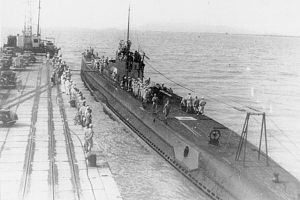Name I-10 Commissioned 31 October 1941 Length 114 m | Fate Sunk, 4 July 1944 Launched 20 September 1939 | |
 | ||
Displacement 2,966 tonnes (2,919 long tons) surfaced4,195 tonnes (4,129 long tons) submerged | ||
The Japanese submarine I-10 was a Type A1 submarine built for the Imperial Japanese Navy (IJN) during the 1930s.
Contents
Design and description
The submarines of the A1 type were versions of the preceding J3 class with superior range, improved aircraft installation, and were fitted as squadron flagships. They displaced 2,966 tonnes (2,919 long tons) surfaced and 4,195 tonnes (4,129 long tons) submerged. The submarines were 113.7 meters (373 ft 0 in) long, had a beam of 9.5 meters (31 ft 2 in) and a draft of 5.3 meters (17 ft 5 in). They had a diving depth of 100 meters (330 ft).
For surface running, the boats were powered by two 6,200-brake-horsepower (4,623 kW) diesel engines, each driving one propeller shaft. When submerged each propeller was driven by a 1,200-horsepower (895 kW) electric motor. They could reach 19 knots (35 km/h; 22 mph) on the surface and 8.25 knots (15.28 km/h; 9.49 mph) underwater. On the surface, the A1s had a range of 16,000 nautical miles (30,000 km; 18,000 mi) at 16 knots (30 km/h; 18 mph); submerged, they had a range of 90 nmi (170 km; 100 mi) at 3 knots (5.6 km/h; 3.5 mph).
The boats were armed with four internal bow 53.3 cm (21.0 in) torpedo tubes and carried a total of 18 torpedoes. They were also armed with a single 14 cm (5.5 in) deck gun and two twin 25 mm (1 in) Type 96 anti-aircraft guns.
Unlike the J3 class, the aircraft hangar is integrated into the conning tower and faces forward; the positions of the deck gun and the catapult were exchanged so the aircraft can use the forward motion of the ship to supplement the speed imparted by the catapult.
Construction and career
On 30 November 1941, I-10, patrolling in the South Sea region in advance of the attack on Pearl Harbor, launched a Yokosuka E14Y floatplane on a night air sortie of Suva Bay in the Fiji Islands. It reported sighting no enemy in the harbor but then failed to return to the sub. The I-10 searched for three days but failed to find the scout.
I-10 conducted long-range operations in the Indian Ocean and the Pacific, using her seaplane to carry out reconnaissance on the harbours of Durban and Port Elizabeth and other locales, including Madagascar during 1942. I-10 was sunk on 4 July 1944 by US warships David W Taylor and Riddle while operating in the Pacific east of Saipan, in the Mariana Islands.
